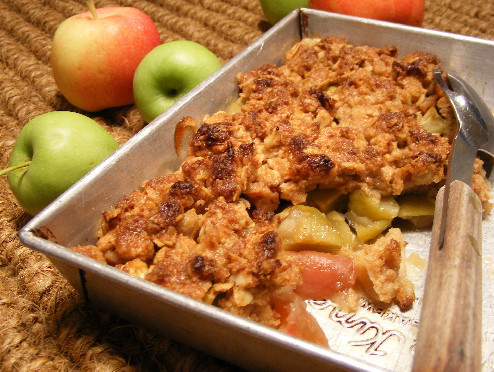Apple: Apple Crisp with Oats
Sunday, September 26th, 2010It’s apple season. It, like the turning of green leaves to golden and crimson hues, is a symbol of fall. In my house and elsewhere, that means it’s time for apple crisp.
I’m more partial to crisps, crumbles and crunches than pies and tarts – not only to make but to eat. I prefer less fuss – sprinkling a quick topping over raw fruit, rather than rolling and pinching dough, and worrying about an undercooked, soggy bottom crust.
A crisp contains flour, butter and sugar that is roughly mixed and scattered atop of fruit. It’s an American adaptation of the British crumble, which some food historians say was developed there around World War II, when food rations called for a sweet alternative to the beloved apple pie they’d been eating since the fifteenth century.
However, other food history authorities suggest that apple crisp and other non-pie variations such as cobbler were introduced in the nineteenth century by the English. Notably, the earliest print reference to apple crisp in American recipes was in 1924 in “Everybody’s Cook Book: A Comprehensive Manual of Home Cookery” by Isabel Ely Lord.
Regardless of its origins, apple crisp is a fall tradition and a good apple crisp is balanced in flavor and texture. Flavor – tart apples and a crisp that’s not overly sweet. Texture – a tender juicy apple filling and a chewy, crisp topping.
In the last few weeks, I’ve already made three apple crisps – the apples always vary but not the crisp.
The apples I use depend on what’s available – Jonathan, Granny Smith, Pink Lady, Braeburn, and other tart varieties. My best crisp is a mix of apples, using some apples to hold shape and others that will melt to make a sweet, juicy filling.
This crisp is my go-to recipe for any fruit-based crisp. I adapted it many years ago from the Plum and Peach Crisp recipe at 101 Cookbooks. It calls for yogurt in lieu of some of the butter. It’s fantastic because the yogurt adds a bit of tanginess to the already tart and sweet (not overly sweet) dessert. My adaptation also calls for fresh cardamom, one of my favorite comforting spices.
Enjoy! I’m interested in hearing about which apple varieties are your favorite for baked desserts.
Tidbits on Apples:
- The large sweet apples that we recognize today descend from wild crabapples from the region of Caucasus in west Asia.
- Apples arrived in the New World with European settlers. The first documented orchard in the U.S. was planted in 1625 in Boston.
- Choose your apples by what you decide to do with it – eating raw versus baking. Select ones that are firm and bruise-free. The “undercast” (the background color) of ripe apples is generally a dull yellow or dull green. For example a light green Granny Smith is ripe, while a very green Granny Smith is under-ripe. Under-ripe apples will ripen quickly when left out at room temperature.
- Store apples in the refrigerator drawer to delay additional ripening. The optimum temperature for apple storage (depending on variety) is between 32 and 40 degrees.






